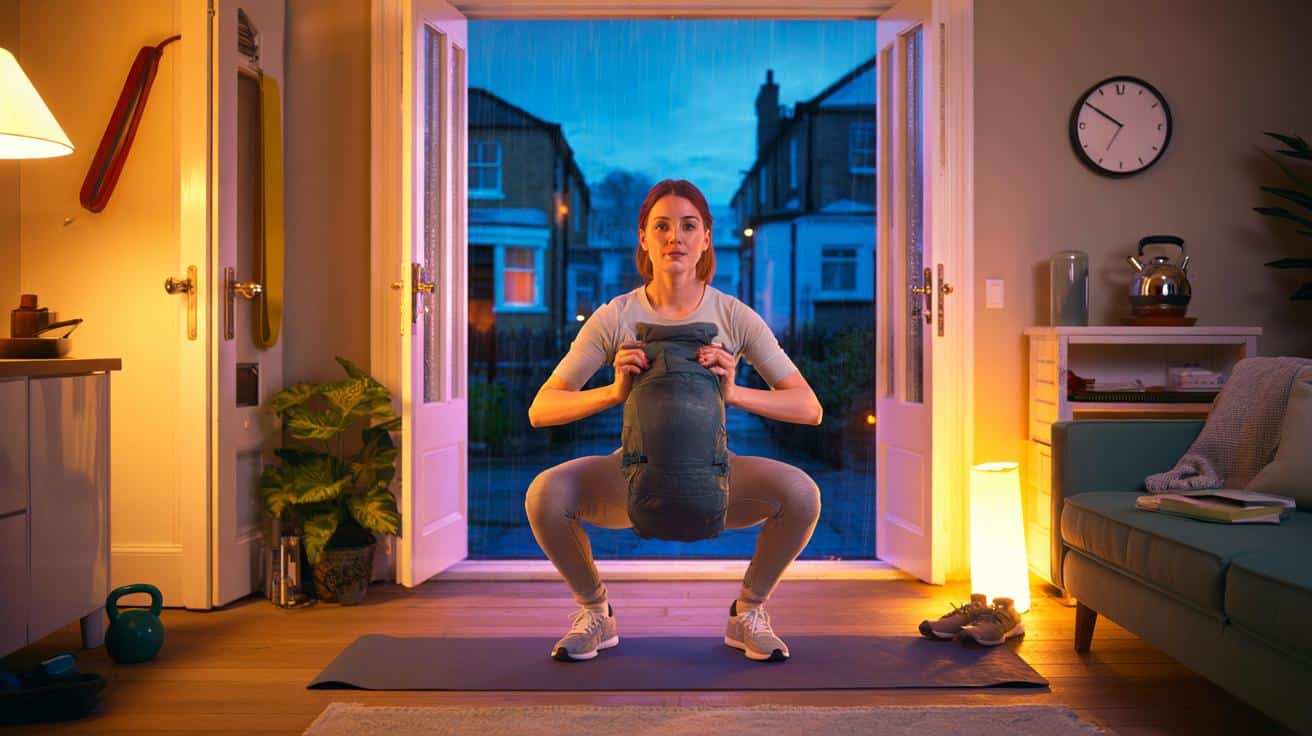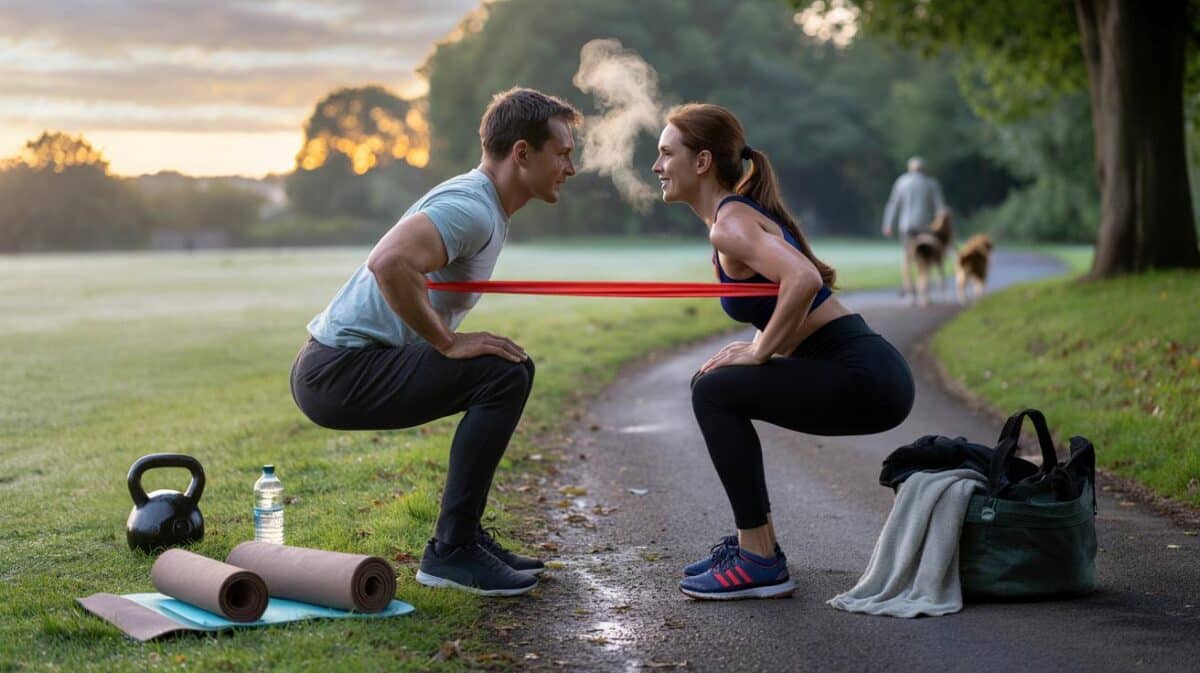Small, repeatable moves can carry you through the bleakest weeks.
The season tilts, the sky darkens early, and plans shrink with the daylight. Your living room, though, can turn into a simple training ground. The trick is to lower the bar to action, not the quality of the work. Small doses, done often, restore rhythm and strength without a commute or a fight with the weather.
Why winter knocks your drive
Short days tug at hormones that govern sleep, hunger and mood. Melatonin rises earlier, and your brain starts whispering about blankets and snacks. That nudge drains the urge to sweat after dusk. No moral failure there. It’s a seasonal shift that asks for gentler entry points.
Light exposure also shapes your body clock. In much of the UK, daylight dips near eight hours in January. Less morning light delays alertness. Evening darkness invites inertia. Layer that with cold pavements and wet wind, and even a short jog feels like a saga.
Reduce friction and act fast: kit within reach, plan pre-written, music on. Lower effort to start, not standards.
Think of motivation as a pilot flame, not lightning. Keep it lit with cues that live in the room you already use. Shoes near the sofa. A mat waiting by the coffee table. A playlist saved as “two songs, then go”. The easier the first step, the more likely you’ll take it.
An indoor plan you can start today
Build a “room circuit” that takes 10–15 minutes. Use four patterns: a push, a pull or hinge, a squat or lunge, and a core hold or carry. Rotate them gently for a week, then try a simple minute-on structure. Keep rest as needed, and stop with one rep in reserve. Joints will thank you.
- Minute rounds: 40 seconds work, 20 seconds reset. Cycle through chair sit-to-stands, incline press-ups on a worktop, hip hinges with a backpack, and a dead bug hold. Repeat for 10 minutes.
- Tempo set: 6 slow goblet squats with a bag (3 seconds down, 1 up), 8 countertop rows using a sturdy strap, 20-second side plank per side. Three rounds.
- Hallway cardio: 30 seconds marching high knees, 30 seconds step-backs, 30 seconds fast toe taps on a book, 30 seconds easy pace. Five rounds.
- Mobility reset: ankle pumps, 90/90 hip switches, cat–cow, shoulder CARs. Two or three unhurried cycles.
Short work counts. Ten minutes, three times a week, beats a heroic blast that never happens.
Make the room do the work
Let your kit live in plain sight. Loop a resistance band on a door handle. Leave a kettlebell beside a plant. Keep a towel on the tiles for slider lunges. Pair movement with daily anchors: while the kettle boils, do 20 calf raises and 10 countertop press-ups; while the oven preheats, flow through hip openers.
Track feelings as well as reps. Note “less stiff”, “warmer hands”, or “steady breath” in a small diary. That feedback builds a loop you can trust when the weather nags.
Evidence and lived experience
Fitness platforms often show a midwinter dip in evening activity, especially after the first two weeks of January. Novelty fades while the cold persists. Shrink the goal instead of abandoning it. Five to fifteen minutes most days adds up to the 75–150 minutes of weekly moderate effort recommended for heart health.
Owen, 41, swapped his dark park run for a stair-and-carry sequence. He stacked it on top of school drop-off. Four flights up, slow walk down, then a suitcase carry with a book-filled rucksack. He kept it to 12 minutes. Within three weeks, he slept deeper, felt steadier in his knees, and stopped grazing at 4pm.
Design for frictionless starts and kind finishes: two-song warm-up, one-minute cool-down, and a note that says “same time tomorrow?”
Progress without pounding pavement
You can hit breath, muscle and mood indoors without jumping or jogs that rattle joints. Use breathing-led tempo, isometric holds, and carries to build strength with little noise. Aim for a perceived effort of 6–7 out of 10 for “working, not wrecked”.
| Goal | 10-minute plan | Effort guide | Kit |
|---|---|---|---|
| Strength | 6 goblet squats, 8 incline press-ups, 10 hip hinges, 20-second hollow hold; repeat | RPE 6–7 | Backpack, worktop |
| Cardio | Stair strides 20 seconds up, walk down; 6–8 rounds; finish with brisk march | RPE 7 | Stairs |
| Mobility | Hip 90/90, thoracic openers, ankle rocks, neck glide; two slow rounds | RPE 3–4 | Mat or towel |
| Core and balance | Suitcase carry across the room, single-leg Romanian deadlift, side plank; repeat | RPE 6 | Loaded bag |
Safety, joints and breath
Warm cold joints with small circles, light marches and gentle breaths. Use nasal breathing for steadier pacing indoors. If wrists complain, use fists or handles. If knees grumble, shorten ranges and slow the descent. If the floor is hard, fold a duvet under knees or hands. Keep the path clear of cables, toys and slick rugs.
Make winter work for you
Attach movement to cues that already happen. Boil the kettle and do 12 countertop rows. Start the news and hold a wall sit for 40 seconds. Brush teeth and stand on one leg. Add a silly ritual: fresh socks, a favourite track, a small candle. Your mind will associate that micro-ceremony with action.
Invite a friend into a low-pressure check-in. “Three songs tonight?” Send a thumbs-up after. Community adds a nudge without judgement. Miss a day? Start again with five minutes. Momentum grows on kindness, not guilt.
Make the first step laughably easy. When you want to quit at minute six, ask for two more minutes. Most times, you’ll stay.
Common pitfalls to avoid
- Chasing sweat as proof. Winter rewards steady efforts that respect joints and nerves.
- Overprogramming. Choose four moves, not fourteen. Repeat them for two weeks, then adjust.
- Hiding equipment. Visible cues beat willpower when light fades.
- Going too hard, too cold. Add two gentle warm-up minutes before any sprint or jump.
- Training in socks on slick floors. Use shoes or place a mat for grip.
Extra ideas that widen the gains
Layer daylight with your indoor plan. Take a five-minute daylight walk at lunch, then do your room circuit before dinner. That blend steadies sleep and mood. Consider vitamin D if you spend most hours indoors; speak with a pharmacist about a suitable dose for winter months.
Try a simple calculation to see impact. Five days of 12 minutes equals an hour a week. Keep that pace for four weeks and you’ve banked four hours of deliberate movement. Add a weekend stair session and you reach the recommended 150 minutes with less strain than a single long run in the rain.
If you like labels, two useful ones help: EMOM means “every minute on the minute”, where you work, then rest within 60 seconds; RPE means “rate of perceived exertion” on a 1–10 scale that guides effort without a heart-rate monitor. Use both to describe how sessions feel, not to chase perfect numbers.
On cramped days, rotate “quiet strength” sessions: wall sits, split-squat holds, suitcase carries, and breathing ladders. They challenge muscles, raise heart rate, and keep neighbours happy. Your room becomes a gym not through gear, but through rhythm, intention and a plan that respects the season you’re living in.








